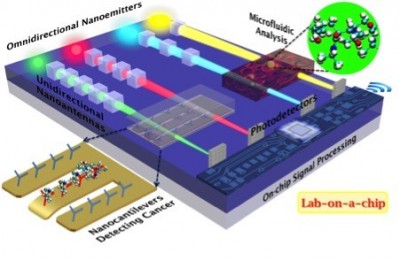4 March 2015
Newly developed tiny optical antennas, which function like spotlights at the nanoscale, offer the potential to measure food safety, identify air pollutants and even quickly diagnose and treat deadly diseases, like cancer.
The new cubic antennas are envisioned for "laboratories-on-a-chip” applications by their inventors, Monash University's Victoria India Doctoral ScholarDebabrata Sikdar from the Department of Electrical and Computer Systems Engineering and his supervisors, Professor Wenlong Cheng and ProfessorMalin Premaratne.
The researchers said their newly designed antennas did a better job than previous spherical antennas at directing an ultra-narrow beam of light where it is needed, with little or no loss due to heating and scattering.
“The cubes are composed of insulating materials, rather than the conducting or semiconducting materials used for the spherical versions, and are easier to fabricate as well as more effective,” Mr Sikdar said.
In a paper published in the Journal of Applied Physics, Mr Sikdar explains that the nanocubes can be arranged in a chain, where the space between them and their number can be adjusted to fine-tune the focused light beam’s width and intensity as needed for various applications. As the separation between cubes increases, the angular width of the beam narrows and directionality improves.
"Unidirectional nanoantennas induce directionality to any omnidirectional light emitters like microlasers, nanolasers or spasers, and even quantum dots," Mr Sikdar said.
Spasers are similar to lasers, but employ minute oscillations of electrons rather than photons of light. Quantum dots, widely used in colour TVs, are tiny crystals that produce specific colours, based on their size.
"The cubic antennas focus light with precise control over direction and beam width," Mr Sikdar said. “They are like nanoscale spotlights.”
The new cubic nanoantennas have the potential to revolutionise the infant field of nano-electro-mechanical systems (NEMS).
"These unidirectional nanoantennas are most suitable for integrated optics-based biosensors to detect proteins, DNA, antibodies, enzymes, etc, in truly portable lab-on-a-chip platforms of the future," Mr Sikdar said.
"They can also potentially replace the lossy on-chip IC (integrated circuit) interconnects, via transmitting optical signals within and among ICs, to ensure ultrafast data processing while minimising device heating."
The research team is now aiming at diverse practical applications of these tiny antennas.
"We would like to collaborate with other research groups across the world to make all these wonders possible," Mr Sikdar said.













